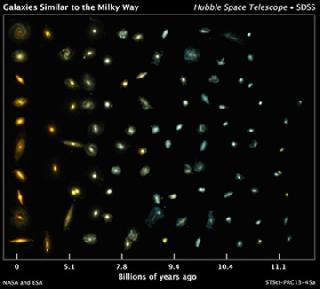
The image shows galaxies similar to the Milky Way. A Hubble photo
WASHINGTON (PTI): NASA's Hubble Space Telescope has provided the first visual evidence of the Milky Way's formative years, suggesting that our home galaxy was a flat disk with a bulge in the middle.
Researchers also found that Milky Way likely began as a faint, blue, low-mass object containing lots of gas. Gas is the fuel for star birth and the blue colour is an indicator of rapid star formation.
Astronomers used Hubble's deep-sky surveys to study the evolution of 400 galaxies similar to the Milky Way and noted their appearance at various stages of development over a time span of 11 billion years.
They found the Milky Way probably was a flat disk with a bulge in the middle, both of which grew simultaneously into the majestic spiral seen today.
The Sun and Earth reside in the disk and the bulge is both full of older stars and home to a supermassive black hole that probably grew along with the galaxy.
"For the first time, we have direct images of what the Milky Way looked like in the past," said study co-leader Pieter G van Dokkum of Yale University in New Haven.
"Of course, we can't see the Milky Way itself in the past. We selected galaxies billions of light-years away that will evolve into galaxies like the Milky Way.
"By tracing the Milky Way's siblings, we find that our galaxy built up 90 per cent of its stars between 11 billion and 7 billion years ago, which is something that has not been measured directly before," he said.
Researchers studied how the structure of the Milky Way changed over time. At the peak of star formation, when the Universe was about 4 billion years old, the Milky Way-like galaxies were pumping out about 15 stars a year.
By comparison, the Milky Way today is creating only one star a year.
"You can see that these galaxies are fluffy and spread out. There is no evidence of a bulge without a disk, around which the disk formed later," said study co-leader Shannon Patel of Leiden University in The Netherlands.
Team member Erica Nelson, of Yale University, added: "These galaxies show us the whole Milky Way grew at the same time, unlike more massive elliptical galaxies, in which the central bulge forms first."
The results were published in The Astrophysical Journal Letters.
 Previous Article
Previous Article Next Article
Next Article













The Indian Air Force, in its flight trials evaluation report submitted before the Defence Ministry l..
view articleAn insight into the Medium Multi-Role Combat Aircraft competition...
view articleSky enthusiasts can now spot the International Space Station (ISS) commanded by Indian-American astr..
view article